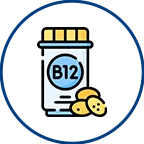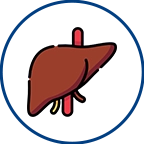Miliaria

Miliaria, commonly known as heat rash or prickly heat, is a skin condition that occurs due to the blockage of sweat ducts. It typically develops in hot and humid environments when sweat cannot escape from the skin properly. Miliaria appears as small, itchy bumps or blisters on the skin and can cause discomfort and irritation. Understanding the potential causes, symptoms, and treatment options for miliaria is essential for managing and preventing this condition.
Home Sample Collection
What causes miliaria?
Miliaria occurs when sweat ducts become blocked, preventing sweat from being released onto the skin's surface. The exact cause of the blockage can vary, but it is commonly associated with factors such as hot and humid weather, excessive sweating, wearing tight or non-breathable clothing, using occlusive skincare products, and being bedridden or immobilized.
What are the common symptoms of miliaria?
Common symptoms of miliaria include the appearance of small, red bumps or blisters on the skin. These bumps may be accompanied by itching, a prickling or stinging sensation, and mild to moderate discomfort. In some cases, miliaria can also cause the affected area to feel warm to the touch.
When should I seek medical attention for miliaria?
Miliaria is usually a self-limiting condition that resolves on its own within a few days to weeks. However, if the symptoms worsen, the rash spreads or becomes more painful, or if you develop signs of infection (such as increased redness, swelling, or pus), it is advisable to consult a healthcare professional for evaluation and appropriate treatment.
How is the diagnosis of miliaria made?
The diagnosis of miliaria is typically made based on the appearance and distribution of the skin rash. A healthcare professional will perform a physical examination to assess the affected area and inquire about your medical history and exposure to hot and humid environments. In most cases, further diagnostic tests are not necessary.
What are the common differential diagnoses for miliaria?
The common differential diagnoses for miliaria include other skin conditions that present with a rash, such as allergic reactions, insect bites, dermatitis, eczema, or fungal infections. A healthcare professional can help differentiate miliaria from these conditions based on the characteristic appearance and distribution of the rash.
Can lifestyle changes help manage miliaria?
Yes, certain lifestyle changes can help manage and prevent miliaria. These may include avoiding hot and humid environments, wearing loose and breathable clothing made of natural fibers, using gentle and non-occlusive skincare products, taking cool showers or baths, keeping the affected area clean and dry, and using a mild, fragrance-free moisturizer to soothe the skin.
Can medications help treat miliaria?
In most cases, miliaria does not require specific medical treatment and resolves on its own. However, if the symptoms are severe or persist, a healthcare professional may recommend over-the-counter hydrocortisone creams or lotions to reduce itching and inflammation. In rare cases, oral antihistamines or antibiotics may be prescribed if there are signs of infection.
Can miliaria be prevented?
Miliaria can often be prevented by taking certain precautions. These include avoiding prolonged exposure to hot and humid environments, using air conditioning or fans to cool the living space, wearing loose and breathable clothing, avoiding excessive physical activity in hot weather, and practicing good hygiene to keep the skin clean and dry.
Can miliaria affect people of all ages?
Yes, miliaria can affect individuals of all ages, from infants to adults. However, it is more commonly observed in infants and young children due to their underdeveloped sweat ducts and difficulty regulating body temperature. Older adults, particularly those with impaired sweating mechanisms, may also be at risk of developing miliaria.
Which healthcare provider should I consult for miliaria?
For miliaria, it is typically sufficient to consult with a primary care physician or a dermatologist. They can evaluate your symptoms, perform necessary examinations, and provide appropriate guidance or treatment based on the severity and extent of the condition.
Book Your Slot
Our Locations Near You in Hyderabad
3KM from Banjara Hills
1.9KM from Yusufguda
3KM from Madhura Nagar
5KM from Shaikpet




